YAMAHA XJR 1300 2000 Repair Manual
Manufacturer: YAMAHA, Model Year: 2000, Model line: XJR 1300, Model: YAMAHA XJR 1300 2000Pages: 95, PDF Size: 2.92 MB
Page 61 of 95
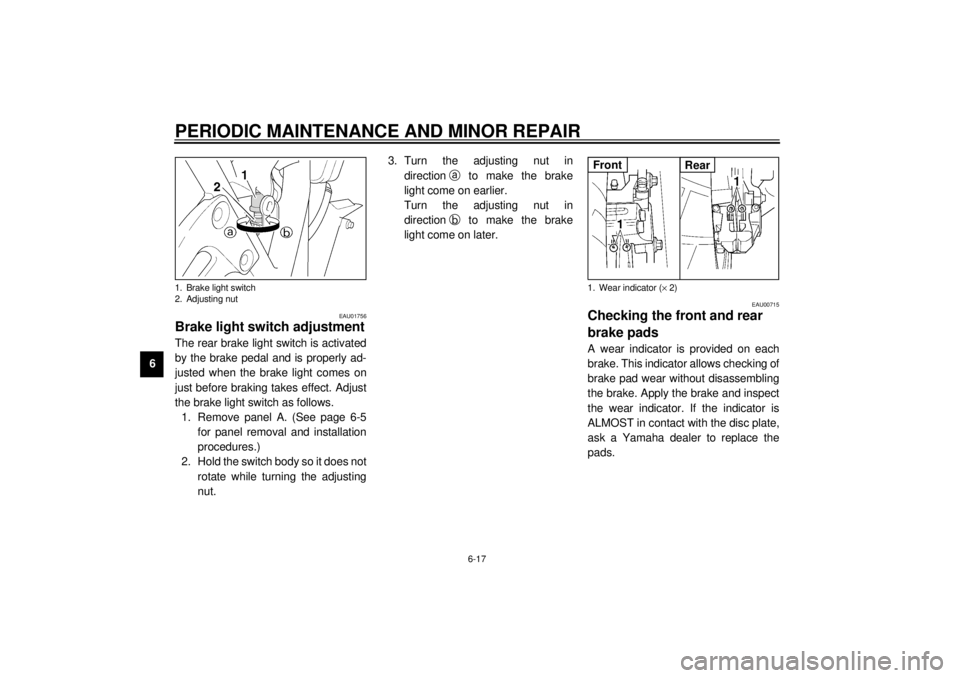
PERIODIC MAINTENANCE AND MINOR REPAIR
6-17
6
EAU01756
Brake light switch adjustmentThe rear brake light switch is activated
by the brake pedal and is properly ad-
justed when the brake light comes on
just before braking takes effect. Adjust
the brake light switch as follows.
1. Remove panel A. (See page 6-5
for panel removal and installation
procedures.)
2. Hold the switch body so it does not
rotate while turning the adjusting
nut.3. Turn the adjusting nut in
direction
a to make the brake
light come on earlier.
Turn the adjusting nut in
direction
b to make the brake
light come on later.
EAU00715
Checking the front and rear
brake padsA wear indicator is provided on each
brake. This indicator allows checking of
brake pad wear without disassembling
the brake. Apply the brake and inspect
the wear indicator. If the indicator is
ALMOST in contact with the disc plate,
ask a Yamaha dealer to replace the
pads.
1. Brake light switch
2. Adjusting nut
1. Wear indicator (´ 2)Front
Rear
Page 62 of 95
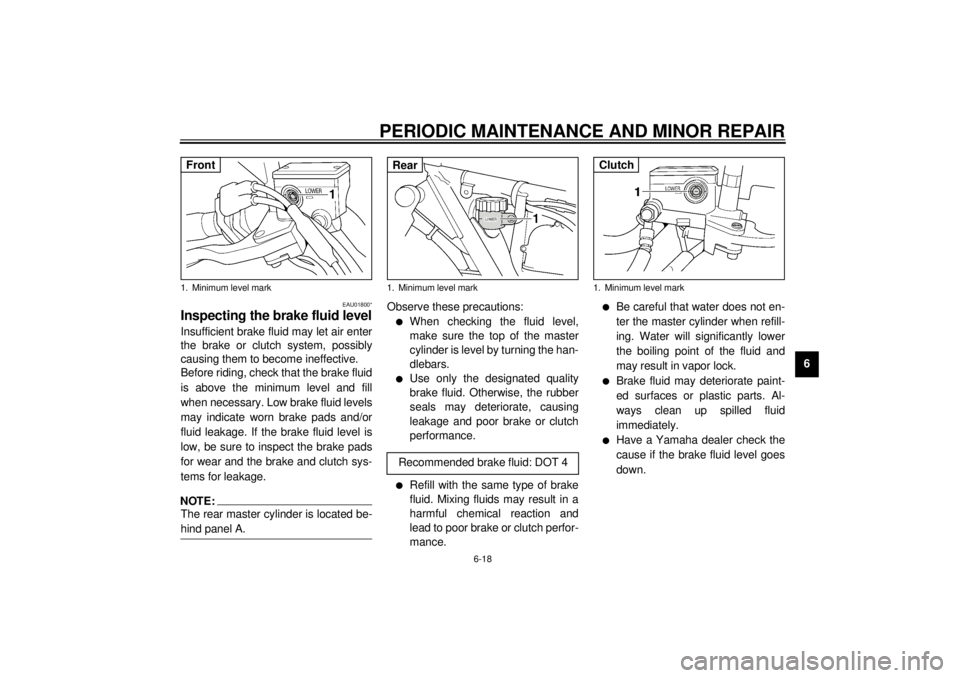
PERIODIC MAINTENANCE AND MINOR REPAIR
6-18
6
EAU01800*
Inspecting the brake fluid levelInsufficient brake fluid may let air enter
the brake or clutch system, possibly
causing them to become ineffective.
Before riding, check that the brake fluid
is above the minimum level and fill
when necessary. Low brake fluid levels
may indicate worn brake pads and/or
fluid leakage. If the brake fluid level is
low, be sure to inspect the brake pads
for wear and the brake and clutch sys-
tems for leakage.NOTE:The rear master cylinder is located be-
hind panel A.
Observe these precautions:l
When checking the fluid level,
make sure the top of the master
cylinder is level by turning the han-
dlebars.
l
Use only the designated quality
brake fluid. Otherwise, the rubber
seals may deteriorate, causing
leakage and poor brake or clutch
performance.
l
Refill with the same type of brake
fluid. Mixing fluids may result in a
harmful chemical reaction and
lead to poor brake or clutch perfor-
mance.
l
Be careful that water does not en-
ter the master cylinder when refill-
ing. Water will significantly lower
the boiling point of the fluid and
may result in vapor lock.
l
Brake fluid may deteriorate paint-
ed surfaces or plastic parts. Al-
ways clean up spilled fluid
immediately.
l
Have a Yamaha dealer check the
cause if the brake fluid level goes
down.
1. Minimum level markFront
1. Minimum level markRecommended brake fluid: DOT 4Rear
1. Minimum level markClutch
Page 63 of 95
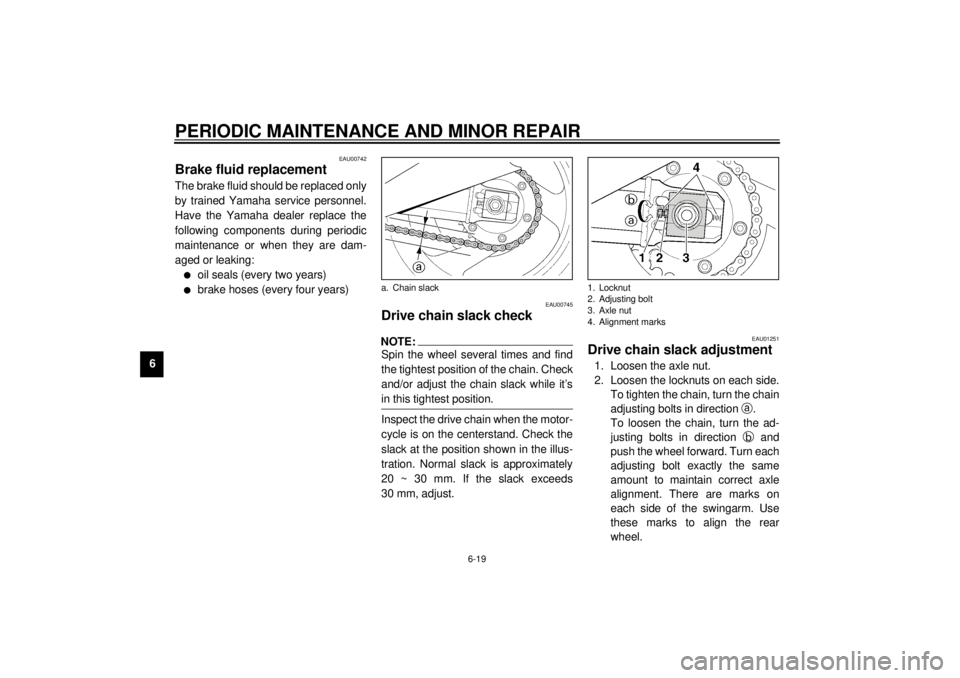
PERIODIC MAINTENANCE AND MINOR REPAIR
6-19
6
EAU00742
Brake fluid replacementThe brake fluid should be replaced only
by trained Yamaha service personnel.
Have the Yamaha dealer replace the
following components during periodic
maintenance or when they are dam-
aged or leaking:l
oil seals (every two years)
l
brake hoses (every four years)
EAU00745
Drive chain slack checkNOTE:@ Spin the wheel several times and find
the tightest position of the chain. Check
and/or adjust the chain slack while it’s
in this tightest position. @Inspect the drive chain when the motor-
cycle is on the centerstand. Check the
slack at the position shown in the illus-
tration. Normal slack is approximately
20 ~ 30 mm. If the slack exceeds
30 mm, adjust.
EAU01251
Drive chain slack adjustment1. Loosen the axle nut.
2. Loosen the locknuts on each side.
To tighten the chain, turn the chain
adjusting bolts in direction
a.
To loosen the chain, turn the ad-
justing bolts in direction
b and
push the wheel forward. Turn each
adjusting bolt exactly the same
amount to maintain correct axle
alignment. There are marks on
each side of the swingarm. Use
these marks to align the rear
wheel.
a. Chain slack
1. Locknut
2. Adjusting bolt
3. Axle nut
4. Alignment marks
Page 64 of 95
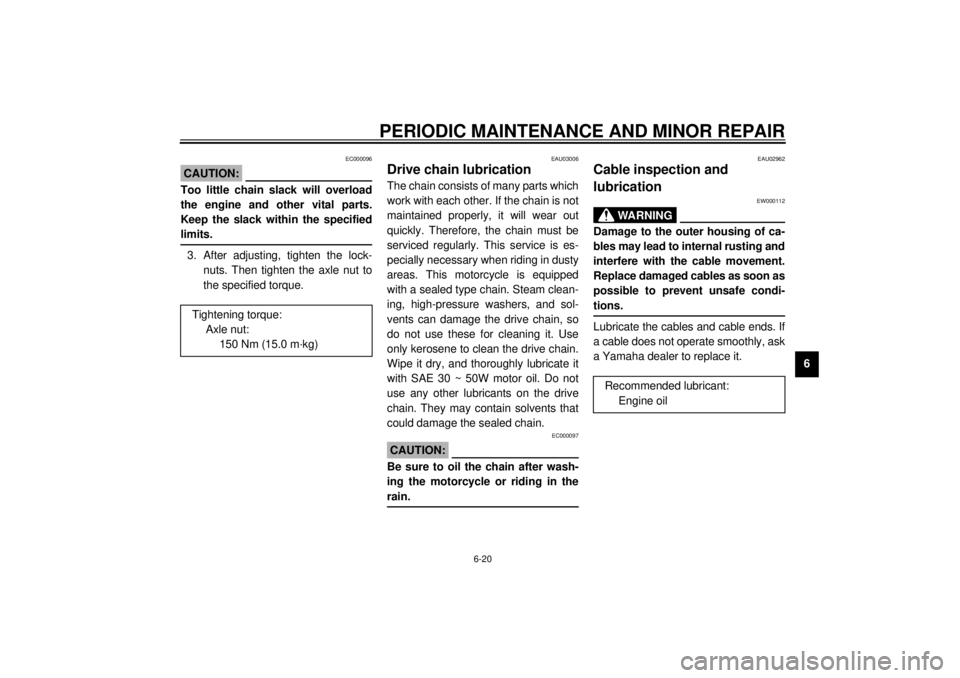
PERIODIC MAINTENANCE AND MINOR REPAIR
6-20
6
EC000096
CAUTION:@ Too little chain slack will overload
the engine and other vital parts.
Keep the slack within the specified
limits. @3. After adjusting, tighten the lock-
nuts. Then tighten the axle nut to
the specified torque.
EAU03006
Drive chain lubricationThe chain consists of many parts which
work with each other. If the chain is not
maintained properly, it will wear out
quickly. Therefore, the chain must be
serviced regularly. This service is es-
pecially necessary when riding in dusty
areas. This motorcycle is equipped
with a sealed type chain. Steam clean-
ing, high-pressure washers, and sol-
vents can damage the drive chain, so
do not use these for cleaning it. Use
only kerosene to clean the drive chain.
Wipe it dry, and thoroughly lubricate it
with SAE 30 ~ 50W motor oil. Do not
use any other lubricants on the drive
chain. They may contain solvents that
could damage the sealed chain.
EC000097
CAUTION:@ Be sure to oil the chain after wash-
ing the motorcycle or riding in the
rain. @
EAU02962
Cable inspection and
lubrication
EW000112
WARNING
@ Damage to the outer housing of ca-
bles may lead to internal rusting and
interfere with the cable movement.
Replace damaged cables as soon as
possible to prevent unsafe condi-
tions. @Lubricate the cables and cable ends. If
a cable does not operate smoothly, ask
a Yamaha dealer to replace it. Tightening torque:
Axle nut:
150 Nm (15.0 m·kg)Recommended lubricant:
Engine oil
Page 65 of 95
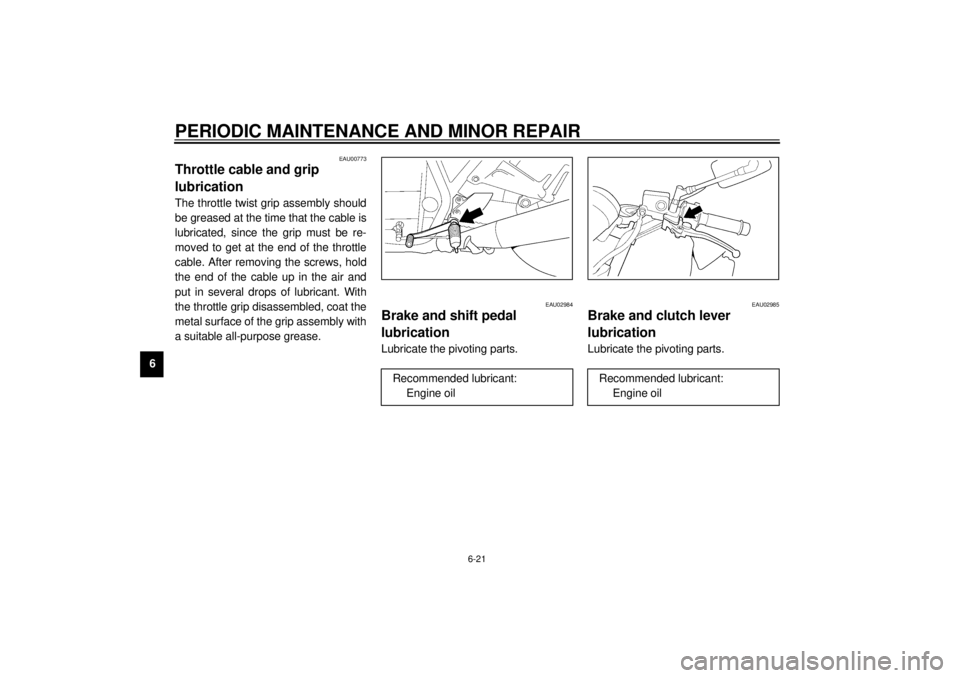
PERIODIC MAINTENANCE AND MINOR REPAIR
6-21
6
EAU00773
Throttle cable and grip
lubricationThe throttle twist grip assembly should
be greased at the time that the cable is
lubricated, since the grip must be re-
moved to get at the end of the throttle
cable. After removing the screws, hold
the end of the cable up in the air and
put in several drops of lubricant. With
the throttle grip disassembled, coat the
metal surface of the grip assembly with
a suitable all-purpose grease.
EAU02984
Brake and shift pedal
lubricationLubricate the pivoting parts.
EAU02985
Brake and clutch lever
lubricationLubricate the pivoting parts.
Recommended lubricant:
Engine oil
Recommended lubricant:
Engine oil
Page 66 of 95
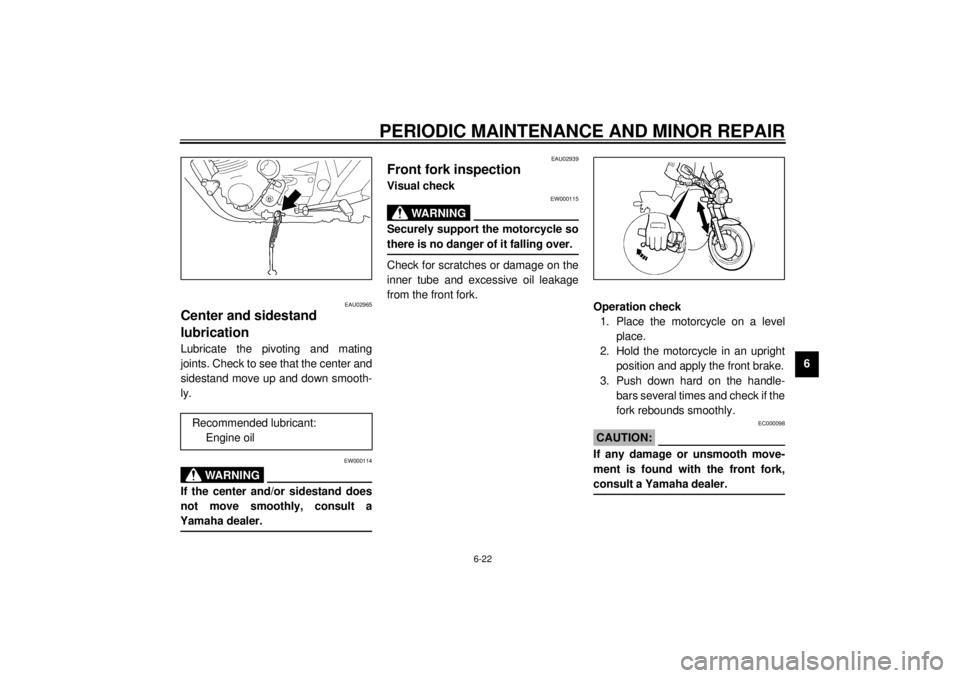
PERIODIC MAINTENANCE AND MINOR REPAIR
6-22
6
EAU02965
Center and sidestand
lubricationLubricate the pivoting and mating
joints. Check to see that the center and
sidestand move up and down smooth-
ly.
EW000114
WARNING
@ If the center and/or sidestand does
not move smoothly, consult a
Yamaha dealer. @
EAU02939
Front fork inspectionVisual check
EW000115
WARNING
@ Securely support the motorcycle so
there is no danger of it falling over. @Check for scratches or damage on the
inner tube and excessive oil leakage
from the front fork.
Operation check
1. Place the motorcycle on a level
place.
2. Hold the motorcycle in an upright
position and apply the front brake.
3. Push down hard on the handle-
bars several times and check if the
fork rebounds smoothly.
EC000098
CAUTION:@ If any damage or unsmooth move-
ment is found with the front fork,
consult a Yamaha dealer. @
Recommended lubricant:
Engine oil
Page 67 of 95

PERIODIC MAINTENANCE AND MINOR REPAIR
6-23
6
EAU00794
Steering inspectionPeriodically inspect the condition of the
steering. Worn out or loose steering
bearings may be dangerous. Place a
stand under the engine to raise the
front wheel off the ground. Hold the
lower end of the front forks and try to
move them forward and backward. If
any free play can be felt, ask a Yamaha
dealer to inspect and adjust the steer-
ing. Inspection is easier if the front
wheel is removed.
EW000115
WARNING
@ Securely support the motorcycle so
there is no danger of it falling over. @
EAU01144
Wheel bearingsIf there is play in the front or rear wheel
hub or if the wheel does not turn
smoothly, have a Yamaha dealer in-
spect the wheel bearings.
EAU01271
BatteryThis motorcycle is equipped with a
sealed-type battery. Therefore it is not
necessary to check the electrolyte or fill
the battery with distilled water.l
If the battery seems to have dis-
charged, consult a Yamaha deal-
er.
l
If the motorcycle is equipped with
optional electrical accessories, the
battery tends to discharge more
quickly, so be sure to recharge it
periodically.
Page 68 of 95
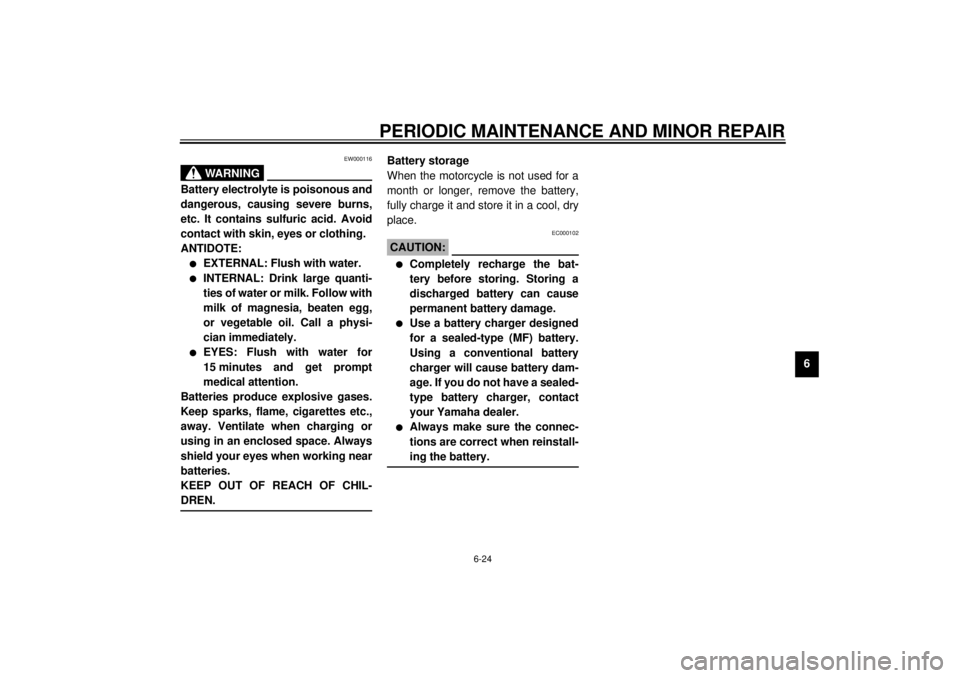
PERIODIC MAINTENANCE AND MINOR REPAIR
6-24
6
EW000116
WARNING
@ Battery electrolyte is poisonous and
dangerous, causing severe burns,
etc. It contains sulfuric acid. Avoid
contact with skin, eyes or clothing.
ANTIDOTE:l
EXTERNAL: Flush with water.
l
INTERNAL: Drink large quanti-
ties of water or milk. Follow with
milk of magnesia, beaten egg,
or vegetable oil. Call a physi-
cian immediately.
l
EYES: Flush with water for
15 minutes and get prompt
medical attention.
Batteries produce explosive gases.
Keep sparks, flame, cigarettes etc.,
away. Ventilate when charging or
using in an enclosed space. Always
shield your eyes when working near
batteries.
KEEP OUT OF REACH OF CHIL-
DREN.
@
Battery storage
When the motorcycle is not used for a
month or longer, remove the battery,
fully charge it and store it in a cool, dry
place.
EC000102
CAUTION:@ l
Completely recharge the bat-
tery before storing. Storing a
discharged battery can cause
permanent battery damage.
l
Use a battery charger designed
for a sealed-type (MF) battery.
Using a conventional battery
charger will cause battery dam-
age. If you do not have a sealed-
type battery charger, contact
your Yamaha dealer.
l
Always make sure the connec-
tions are correct when reinstall-
ing the battery.
@
Page 69 of 95
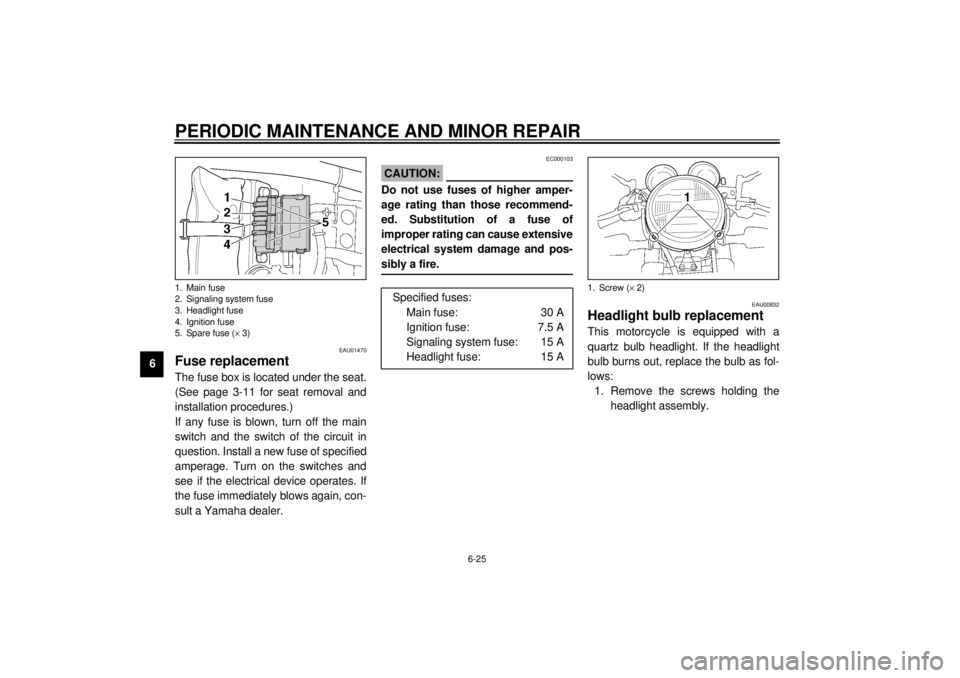
PERIODIC MAINTENANCE AND MINOR REPAIR
6-25
6
EAU01470
Fuse replacementThe fuse box is located under the seat.
(See page 3-11 for seat removal and
installation procedures.)
If any fuse is blown, turn off the main
switch and the switch of the circuit in
question. Install a new fuse of specified
amperage. Turn on the switches and
see if the electrical device operates. If
the fuse immediately blows again, con-
sult a Yamaha dealer.
EC000103
CAUTION:@ Do not use fuses of higher amper-
age rating than those recommend-
ed. Substitution of a fuse of
improper rating can cause extensive
electrical system damage and pos-
sibly a fire. @
EAU00832
Headlight bulb replacementThis motorcycle is equipped with a
quartz bulb headlight. If the headlight
bulb burns out, replace the bulb as fol-
lows:
1. Remove the screws holding the
headlight assembly.
1. Main fuse
2. Signaling system fuse
3. Headlight fuse
4. Ignition fuse
5. Spare fuse (´ 3)
Specified fuses:
Main fuse: 30 A
Ignition fuse: 7.5 A
Signaling system fuse: 15 A
Headlight fuse: 15 A
1. Screw (´ 2)
Page 70 of 95
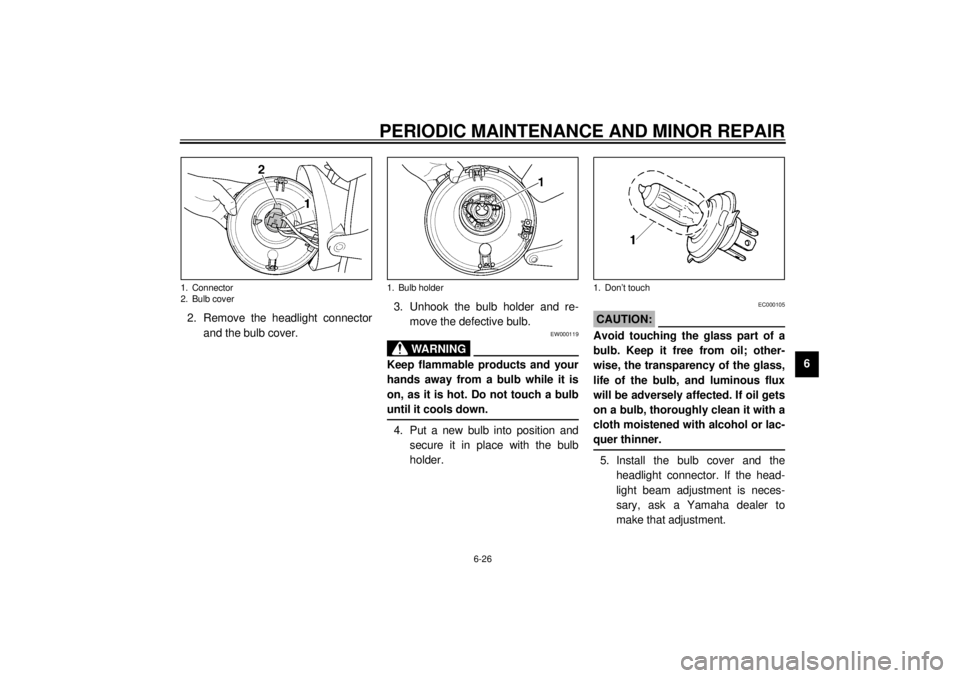
PERIODIC MAINTENANCE AND MINOR REPAIR
6-26
6 2. Remove the headlight connector
and the bulb cover.3. Unhook the bulb holder and re-
move the defective bulb.
EW000119
WARNING
@ Keep flammable products and your
hands away from a bulb while it is
on, as it is hot. Do not touch a bulb
until it cools down.@4. Put a new bulb into position and
secure it in place with the bulb
holder.
EC000105
CAUTION:@ Avoid touching the glass part of a
bulb. Keep it free from oil; other-
wise, the transparency of the glass,
life of the bulb, and luminous flux
will be adversely affected. If oil gets
on a bulb, thoroughly clean it with a
cloth moistened with alcohol or lac-
quer thinner. @5. Install the bulb cover and the
headlight connector. If the head-
light beam adjustment is neces-
sary, ask a Yamaha dealer to
make that adjustment.
1. Connector
2. Bulb cover
1. Bulb holder
1. Don’t touch